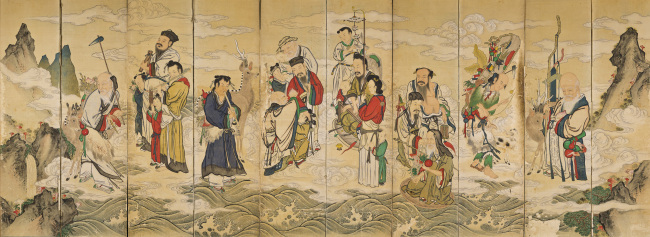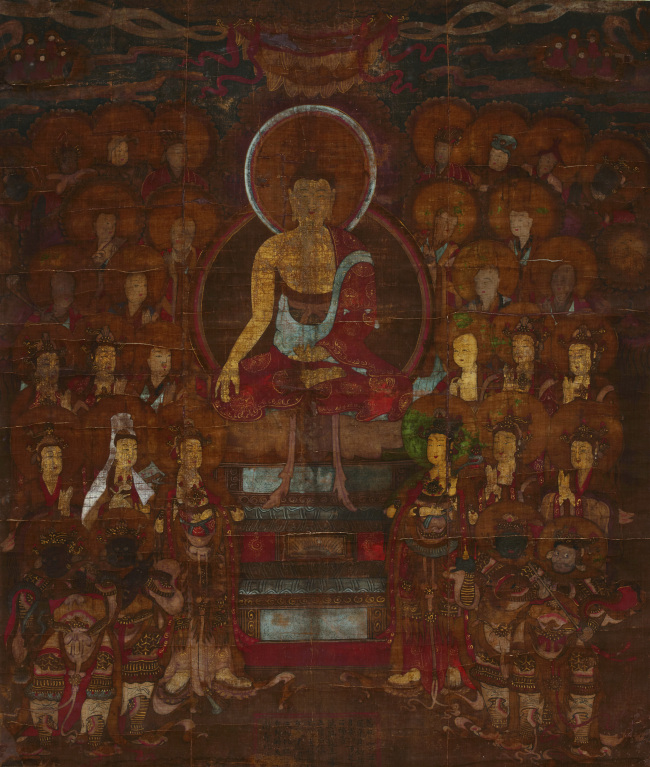 |
“Immortals,” a 10-panel folding screen. ( Seoul Auction) |
Two old Korean paintings, one given away as a gift, the other looted, finally returned to their home country and found new owners at an auction Wednesday in Seoul.
A granddaughter of German businessman Carl Andreas Wolter, who established the first trading company in Korea in the early 1900s, brought back to Korea a painting that was presented to her grandfather by Emperor Gojong to be auctioned.
On Wednesday the 10-panel folding screening was sold at 660 million won ($574,162) by Seoul Auction in a heated bid. The starting price was 280 million won.
 |
“Sakyamuni Platform Painting,” 1592. (Seoul Auction) |
Barbara Michel-Jaegerhuber, 91, watched as the painting her family inherited found a new owner at Wednesday’s auction. It was her mother’s will to return the painting back to where it came from.
“I am happy to realize the wishes of my parents and me. I know the value of artwork because I am a painter myself. I think the Korean painting should be appreciated by Koreans. I am pleased to return the painting, especially in the year of the 130th anniversary of diplomatic relations between Korea and Germany,” said Michel-Jaegerhuber.
Her grandfather Wolter received the painting drawn on a 10-panel folding screen from Emperor Gojong as a gift and brought it with him when he left the country in 1905. The painting was handed down to one of Wolter’s daughters, who is Jaegerhuber’s mother, in 1916 and had been kept safely despite going through the first and second World Wars.
“My family kept it for over four generations safely even through two World Wars and we guarded the folding screen zealously,” wrote Jaegerhuber in a letter to the painting’s new owner.
“This screen therefore has been a very important part in my 91-year life and my biggest wish is to see the ‘gods’ returning home to their origin in Korea during my lifetime. I still have fond memories of my close ties to my grandfather back in Incheon/Korea, and I still remember many stories from my mother from back then,” she wrote.
The painting features 12 Taoist hermits, which Jaegerhuber referred to as “gods.” The painting was created to mark a royal celebration and represents happiness for the royals, according to the auction house.
Jaegerhuber said she grew up listening to interesting stories her mother told her about life she had growing up in Korea. Wolter spent 20 years in Korea raising his seven children. Five of them were born in Korea, including Jaegerhuber’s mother.
“Jaegerhuber told us she heard the story of the painting and the story of her mother growing up in Korea back then,” said Baek Da-hyun, in charge of promotional work at Seoul Auction. “She said her family kept the painting well and took it out and displayed it at home during special occasions like Christmas,” she said.
The auction catalogue noted that the painting is surprisingly well preserved despite having been stored at an ordinary home for more than 100 years. The bottom part of the second panel was partially damaged because of humidity. The painting, however, still clearly shows bright colors, meticulously detailed lines, sophisticated composition and background settings.
Another sale at the same auction marked the return of a 16th century Buddhist painting.
The painting was looted by Japanese soldiers during the Japanese invasion of Korea from 1592-1598 and had been kept in the historical city of Kyoto, Japan for 420 years.
“The repatriation was made by a Korean art historian who convinced the owner of the painting patiently over two to three years,” said Baek. “And now it has found a new owner,” she said, declining to name both of her clients due to auction house’s rules.
The painting, considered to have high artistic and historical value showing the early painting style of the Joseon period, was sold for 830 million won, the highest price achieved by Seoul Auction’s 128th sale.
By Lee Woo-young (
wylee@heraldcorp.com)









